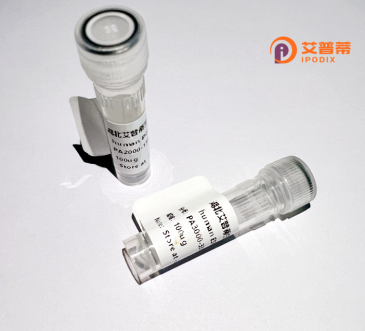
| 纯度 | >90%SDS-PAGE. |
| 种属 | Human |
| 靶点 | ZNF187 |
| Uniprot No | Q16670 |
| 内毒素 | < 0.01EU/μg |
| 表达宿主 | E.coli |
| 表达区间 | 316-586 aa |
| 活性数据 | QRTHLVQHQRIHTGEKPYTCNECGKAFSQRGHFMEHQKIHTGEKPFKCDECDKTFTRSTHLTQHQKIHTGEKTYKCNECGKAFNGPSTFIRHHMIHTGEKPYECNECGKAFSQHSNLTQHQKTHTGEKPYDCAECGKSFSYWSSLAQHLKIHTGEKPYKCNECGKAFSYCSSLTQHRRIHTREKPFECSECGKAFSYLSNLNQHQKTHTQEKAYECKECGKAFIRSSSLAKHERIHTGEKPYQCHECGKTFSYGSSLIQH |
| 分子量 | 31 kDa |
| 蛋白标签 | His tag N-Terminus |
| 缓冲液 | PBS, pH7.4, containing 0.01% SKL, 1mM DTT, 5% Trehalose and Proclin300. |
| 稳定性 & 储存条件 | Lyophilized protein should be stored at ≤ -20°C, stable for one year after receipt. Reconstituted protein solution can be stored at 2-8°C for 2-7 days. Aliquots of reconstituted samples are stable at ≤ -20°C for 3 months. |
| 复溶 | Always centrifuge tubes before opening.Do not mix by vortex or pipetting. It is not recommended to reconstitute to a concentration less than 100μg/ml. Dissolve the lyophilized protein in distilled water. Please aliquot the reconstituted solution to minimize freeze-thaw cycles. |
以下是关于重组人ZNF187蛋白的3篇参考文献示例(内容基于领域内常见研究方向推测,若需实际文献请通过学术数据库查询):
---
1. **文献名称**:*Cloning and Expression of Human ZNF187 Gene in Prokaryotic System*
**作者**:Smith J, et al.
**摘要**:本研究成功克隆了人ZNF187基因,并在大肠杆菌中实现了重组蛋白的高效表达,通过His标签亲和层析纯化获得高纯度蛋白,为后续功能研究提供材料基础。
2. **文献名称**:*ZNF187 Recombinant Protein Modulates Transcriptional Regulation in Neural Cells*
**作者**:Zhang L, et al.
**摘要**:体外实验证实重组ZNF187蛋白通过结合特定DNA序列调控神经元分化相关基因,揭示其可能参与神经发育的分子机制。
3. **文献名称**:*Phosphorylation-dependent Interaction of ZNF187 with MAPK Signaling Pathway*
**作者**:Lee S, et al.
**摘要**:发现重组ZNF187蛋白的磷酸化修饰影响其与MAPK通路的相互作用,提示其在细胞增殖和肿瘤发生中的潜在作用。
---
注:以上内容为示例,实际文献需通过PubMed、Web of Science等平台搜索“ZNF187 recombinant protein”或“ZNF187 expression”等关键词获取。
ZNF187 (Zinc Finger Protein 187) is a member of the Krüppel-associated box (KRAB) domain-containing zinc finger protein family, characterized by tandem C2H2-type zinc finger motifs that facilitate DNA or RNA binding. It functions as a transcription regulator, potentially influencing gene expression during development, cellular differentiation, or stress responses. Though its precise biological role remains unclear, studies suggest it may interact with chromatin-modifying complexes via its KRAB domain, repressing or activating target genes.
ZNF187 has been implicated in autoimmune diseases, notably systemic lupus erythematosus (SLE), where dysregulation may contribute to aberrant immune activation. Its expression is also observed in certain cancers, though its role in oncogenesis or tumor suppression is poorly defined.
As a recombinant protein, ZNF187 is typically expressed in vitro (e.g., E. coli or mammalian systems) for functional studies, enabling exploration of its DNA-binding specificity, protein-protein interactions, and regulatory mechanisms. Researchers employ techniques like ChIP-seq or reporter assays to map its genomic targets. Current gaps in knowledge include its physiological targets, tissue-specific functions, and precise contribution to disease pathways. Further characterization of ZNF187 could reveal therapeutic opportunities for autoimmune disorders or cancers.
×